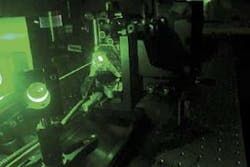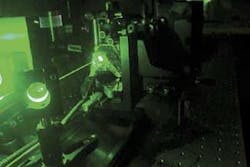CONFERENCE OVERVIEW: Fiber-lasers conference presents the leading edge
Leading developers of fiber-laser technology reviewed the current state of the art in fiber lasers at “Fiber Lasers II: Technology Systems and Applications,” a conference held as part of SPIE’s Photonics West 2005 (Jan. 24-27; San Jose, CA). Over the last few years, the rapid advance of high-power fiber lasers has been a highlight of this fiber-laser conference. In 2003, key developments included continuous-wave fiber lasers with up to 500 W of output power. In 2004, the power had increased to 1 kW. This year, in the session on late-breaking developments, fiber lasers in the 1.5- to 2-kW range were described. Beam-combining schemes that could offer multikilowatt operation from arrays of fiber lasers were also discussed.
Of particular note, IPG Photonics (Oxford, MA) reported output powers of 1.96 kW from a fiber MOPA (master-oscillator power-amplifier) system, researchers from the Friedrich Schiller University (Jena, Germany) reported a 1.5-kW output from a photonic-crystal fiber, and David Payne from the University of Southampton (Southampton, England) discussed new fiber-design requirements for scaling single fibers to 10-kW power levels.
At the same time as record continuous-wave powers are being demonstrated, there have been significant advances in output energy and peak power from pulsed lasers with operation ranging from the nanosecond to femtosecond regimes. A joint session with the conference on ultrafast lasers highlighted the state of the art in ultrashort-fiber-laser development and applications. In the nanosecond regime, researchers continue to push the peak powers into the multikilowatt region at both 1 and 1.5 µm with a trend toward demonstration of all-fiber systems. This year’s best student paper award, contributed by SPI (Southampton, England), went to Thomas Schreiber from the Friedrich Schiller University for his work on high-peak-power ultrashort-pulse generation.
Advances in building blocks for fiber lasers, such as pump couplers and integrated gain blocks or modules, will also play a key role in the future development of this field and broad adoption of fiber technology into industrial applications. Talks from OFS-Fitel (Norcross, GA) and Sifam (Devon, England) provided current status on the development of pump couplers, while Nufern (East Granby, CT) and Crystal Fibre (Birkerod, Denmark) provided information on integrated subassemblies. In particular, Crystal Fibre discussed subassemblies featuring ytterbium (Yb)-doped photonic-crystal fibers with a 200-W output power, while Nufern, in collaboration with the University of Michigan (Ann Arbor, MI), presented a single-polarization fiber-laser module with an output power of greater than 300 W.
Continued advances in new fibers, materials, and techniques to extend the regime of high-power fiber lasers and systems toward longer or shorter wavelengths are other important aspects of future fiber-laser development. New wavelengths can be accomplished either directly from new or improved fibers, or by using fibers as pumps for nonlinear conversion. In this latter area, Aculight (Bothell, WA) presented results on the generation of 60 W of green output from a frequency-doubled Yb fiber laser (see figure). Lawrence Livermore National Laboratory (Livermore, CA) also discussed high-power yellow generation from a fiber-based source. Roy Taylor from Imperial College (London, England) and several other speakers provided the status of fiber lasers for generating multiwatt supercontinuum generation and their applications.
A panel discussion on the “Grand Challenges of Fiber Lasers” closed the conference. Panel members representing the user community, laser manufacturers, and component suppliers provided their insights into the challenges asubsubhead for broad adoption of fiber lasers into industrial and commercial markets. Audience questions covered topics from what it will take to get fiber lasers broadly adopted in high-volume applications and whether fiber lasers can open up new markets or just take market share from existing lasers, to company business models, component reliability, and cost drivers.
The conference will be held again at Photonics West in 2006.
Andrew J.W. Brown
Andrew Brown is director of business development for Aculight in Bothell, Washington. He was the cochair of the Fiber Lasers II: Technology Systems and Applications conference at Photonics West 2005.

